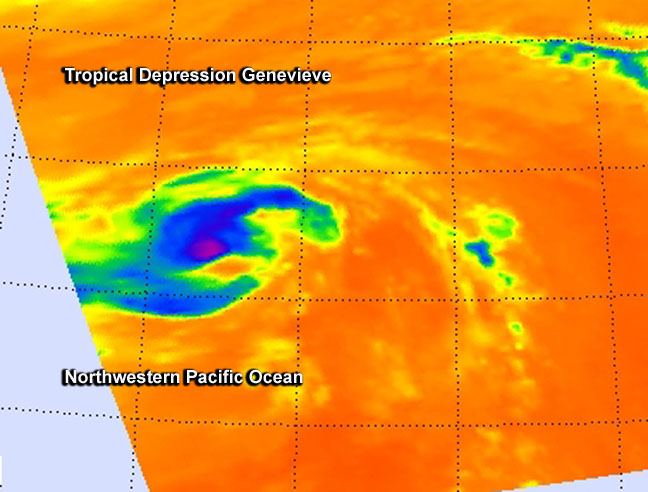NASA Sees the End of Tropical Depression Genevieve

NASA's Aqua satellite passed over Tropical Depression Genevieve on Aug. 11 at 01:29 UTC. A small area of the strongest thunderstorms (purple) were occurring over the northern quadrant. Image Credit: NASA JPL, Ed Olsen
Genevieve moved through all three Pacific Ocean regions (eastern, central and western) in its two week lifetime and met its end today.
NASA's Aqua satellite passed over Tropical Depression Genevieve on Aug. 11 at 01:29 UTC and the Atmospheric Infrared Sounder (AIRS) captured infrared data on the storm.
AIRS data showed a small area of the strongest thunderstorms were occurring over the northern quadrant, where temperatures approached -63F/-52C. That area was where where the heaviest rain was located.
The Joint Typhoon Warning Center issued its final bulletin on Tropical depression Genevieve on Monday at 2100 UTC (4 p.m. EDT). At that time, Genevieve was located near 34.9 north and 167.6 east, that's about 940 nautical miles north of Wake Island.
It was moving to the northwest at 8 knots (9.2 mph/14.8 kph) and maximum sustained winds had dropped to 25 knots (28.7 mph/46.3 kph).
Genevieve was born in the Eastern Pacific, moved through the Central Pacific and into the Western Pacific where it finally became a typhoon, actually a super-typhoon.
Genevieve made that Pacific Ocean trek over a period of two weeks and its journey has ended in the Northwestern Pacific Ocean as the storm dissipated on August 12.
Text credit: Rob Gutro
NASA's Goddard Space Flight Center
Media Contact
More Information:
http://www.nasa.govAll latest news from the category: Earth Sciences
Earth Sciences (also referred to as Geosciences), which deals with basic issues surrounding our planet, plays a vital role in the area of energy and raw materials supply.
Earth Sciences comprises subjects such as geology, geography, geological informatics, paleontology, mineralogy, petrography, crystallography, geophysics, geodesy, glaciology, cartography, photogrammetry, meteorology and seismology, early-warning systems, earthquake research and polar research.
Newest articles

Economies take off with new airports
A global study by an SUTD researcher in collaboration with scientists from Japan explores the economic benefits of airport investment in emerging economies using nighttime satellite imagery. Be it for…

CAR T–cell immunotherapy targets
Pan-cancer analysis uncovers a new class of promising CAR T–cell immunotherapy targets. Scientists at St. Jude Children’s Research Hospital found 156 potential CAR targets across the brain and solid tumors,…

Stony coral tissue loss disease
… is shifting the ecological balance of Caribbean reefs. The outbreak of a deadly disease called stony coral tissue loss disease is destroying susceptible species of coral in the Caribbean…





















